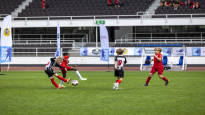As many as 27,000 juniors will play in the Helsinki Cup this year. Tournament CEO Kirsi Kavanne says that keeping the price level moderate is important.
The Helsinki Cup, which started yesterday, is one of the world’s biggest junior football tournaments. The tournament, which gathers participants from as far away as Mexico and Taiwan, is a profitable business in addition to a football celebration.
With the exception of the corona years, the tournament has made a significant financial profit every year. The company’s net profit was 107,000 euros in the last fiscal year.
PK-37 from Iisalme is participating in the hobby series for 11-year-old boys. Team leader Asta Kalanti says that the tournament is, above all, an experience for juniors. A trip to the tournament, less than 500 kilometers away from the hometown, is traditionally paid for with allowances and the support of parents.
The total costs consist of the participation fee, four nights’ accommodation in a hotel, three meals a day and train travel.
– As a team, this has cost us around 3,500 euros. The price per junior is around 400 euros. In addition, the boys get a little spending money for the trip, Kalanti opens up the whole.
The team collected almost 750 euros with the taluks. The remainder remaining for the players’ parents is divided into the monthly payments of the participating juniors.
CEO of Helsinki Cup Kirsi Kavanteen according to the organizers, it is important that the costs of the tournament for the clubs remain humane. He says that the tournament prices had to be increased only minimally from last year. Collaborators play a key role in the whole.
– It is really important that we are able to organize, for example, such accommodation options that everyone has the opportunity to stay, Kavanne emphasizes.
According to the plan, most of the teams stay in hotels. Accommodation is also available at two schools.
Cheaper than in the western neighbor
Unlike most Finnish sports events, the Helsinki Cup is not run by volunteers. Kavanne says that approximately 700 people are needed to complete the tournament, each of whom receives a salary.
According to Kavantee, the popularity of the Helsinki Cup is influenced, among other things, by the quality and conditions of the fields, the tradition of the tournament, and the attractiveness of Helsinki as a capital and holiday destination.
The international major tournament has also been successful in its pricing. Kavanne says that the prices are currently more moderate than, for example, in the Gothia Cup, which will be played next week in Gothenburg, Sweden.
– For example, we have been successful in negotiations on accommodation contracts, that’s why we haven’t had to raise accommodation prices, says Kavanne.
The tournament attracts as many as 1,796 teams to the capital this year, which is a record number. In 2011, there were 777 teams. Kalanti says that Helsinki offers great experiences to those coming from further afield, even outside of the games. At the time of the interview, the team is at the amusement park.
– There is much more here that we can do in connection with the tournament. I think this is a reasonably priced tournament, says Kalanti.
Kavanne says that the financial profits of the tournament will be used to develop the Helsinki Cup. According to him, the tournament has invested especially in girls’ football in recent years.
– We have succeeded in that, because now we have more than 300 girls’ teams participating in the tournament, Kavanne reveals.
Through the two sports clubs that own the Helsinki Cup, funds are also channeled more widely into junior football.
According to the CEO, the tournament, which has become gigantic, still has room to grow. The high-quality pitches in Helsinki, Espoo and Vantaa could accommodate a few hundred more teams, Kavanne estimates. Participants are wanted from abroad as well as from Finland.
– We need more international teams and countries’ flags. They are also a wealth for domestic teams. Just as important are the teams that come from the provinces to bring color to Uusimaa’s teams, Kavanne reflects.
Kalanti hopes that the tournament week will leave many good memories for the juniors from Savoia. The team leader has sensed the boys’ enthusiasm from the beginning.
– The boys are absolutely in their prime, and everyone was very nervous when they left, Kalanti smiles at the beginning of the tournament.
